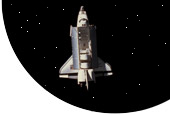NASA details new space goals to staff
Employee presentation stresses affordability of plan
http://msnbc.msn.com/id/4018250/
By James Oberg, NBC News space analyst, Special to MSNBC
Updated: 5:03 p.m. ET Jan. 21, 2004
In a presentation now being delivered to NASA employees across the country, the space agency is providing details of how it plans to implement the broad new space goals announced by President Bush last week. The presentation, a copy of which was obtained by MSNBC.com, includes a list of guiding principles, specific program plans and details of budgetary rearrangements.
“The shift in funding reflects the priority of the new national vision for human and robotic exploration of the solar system and beyond,” the report explains.
It also directly challenges the most widespread criticism of the new plans, which is that they are too expensive. The report stresses that NASA;s annual budget (about 0.7 percent of the federal budget), at about 15 cents per person per day, is equivalent to the cost of "a month of cable" or "a family trip to a movie".
Without Bush’s new “exploration vision,” the report claims it was likely that next year’s budget “would have been considerably reduced” and would have lost even more ground through inflation. Instead, NASA now expects the budget to increase by 5 percent per year over the next three years, and thereafter at about 2 percent annually to cover inflation.
NASA Administrator Sean O'Keefe said Wednesday that the agency's proposed budget for fiscal year 2005 would be $16.2 billion, which is a 5.6 percent increase over the 2004 budget of $15.4 billion. The proposed increase for FY 2006 would be 4.8 percent, with a 4.7 percent increase in FY2007 before dropping to a 1.5 percent increase in FY 2008.
Plans to retire the space shuttle in 2010 and develop of the replacement spacecraft, the “Crew Exploration Vehicle” no later than 2014, have already been widely publicized. However, contrary to published reports, NASA shows no intention of canceling the International Space Station anytime soon.
The report shows current funding levels for ISS continuing through fiscal year 2016, while NASA plans to “refocus research to exploration factors affecting astronaut health”. The presentation adds that NASA also will “acquire crew and cargo systems, as necessary, during and after availability of shuttle.”
The biggest budgetary shift is scheduled for fiscal years 2010 to 2012, when annual space shuttle spending drops from $4.5 billion to zero and the allocation to “exploration missions” doubles. A near-billion-dollar category called “ISS Transport” continues for years beyond this date.
Sustainable and affordable strategies
Exploration of the solar system, says the presentation, will be guided by “compelling scientific and societal importance.” In keeping with already-established mission statements, “NASA exploration missions will seek profound answers to questions of our origins, whether life exists beyond Earth, and how we could live on other worlds.”
This exploration will be shaped by recent discoveries and will focus on "likely habitable environments" including Mars, the moons of Jupiter, and telescopic searches “for Earth-like planets and habitable environments around other stars.”
Both robots and astronauts will be used in this effort, the presentation stresses, “leveraging the capabilities of each where useful.” Robotic probes will go first, test new technology, gather science data, and identify usable resources. Astronauts in turn will “conduct in-depth research, direct and upgrade advanced robotic explorers, prepare space resources, and demonstrate new exploration capabilities.”
“Where advantageous,” the presentation continues, “NASA will also make use of destinations like the moon and near-Earth asteroids to test and demonstrate new exploration capabilities.” A new wave of robotic explorers will begin to explore the moon by 2008, with human expeditions planned “in the 2015 – 2020 timeframe.”
This will not be Apollo redux, however. Rather than “flags and footprints,” this new wave of exploration is aimed at developing "sustainable, affordable, and flexible strategies,” the report says. “The vision is not about one-time events and, thus, costs will be reduced to maintain the affordability of the vision.”
While NASA’s next budget, due Feb. 6, will include some realignment of funding, the biggest re-allocations will not occur until the FY06 budget, which will “address uncertainties in implementing the vision.”
Ultimate human missions to Mars are not given a specific schedule. “Timing of human missions to Mars,” the presentation explains, “will be based on available budgetary resources, experience and knowledge gained from lunar exploration, discoveries by robotic spacecraft at Mars and other solar system locations, and development of required technologies and know-how.”
Many of these goals are not yet within existing capabilities, the presentation acknowledges, laying out a plan for NASA to develop new technology in the areas of “power generation, propulsion, life support, and other key capabilities required to support more distant, more capable, and/or longer duration human and robotic exploration”.
Unmanned probes to continue
The presentation stresses that the new space vision does not mean that other unmanned space probes will be cancelled. NASA will continue to “conduct robotic exploration across the solar system for scientific purposes and to support human exploration.” In particular, it will “explore Jupiter’s moons, asteroids, and other bodies to search for evidence of life, to understand the history of the solar system, and to search for resources.”
This new vision, the presentation states, benefits the nation because it “makes needed decisions to secure long-term U.S. space leadership, encourages innovation and strengthens [the] industrial base, [and] pursues compelling science and inspires the next generation of explorers.”
The plan also “refocuses NASA”, by establishing an “exciting long-term vision” and by integrating robotic and human programs “around focused science goals”. It also responds to recommendations of the Columbia Accident Investigation Board concerning the need for a new long-term space goal and a practical plan to manage the end of the space shuttle program.
No mention is made in this presentation of a theme repeatedly stressed in President Bush’s speech, that of international cooperation and partnership. Nor is any allusion made to joint work with other U.S. government agencies involved in space technology.
However, the presentation promises that a detailed “Exploratory Vision Document”, linking the plans with actual programs, will be released with the FY 2005 budget on Feb 2. |

